Everyone knows 2020 was arguably the most unusual year in anyone’s recollection. In such a time of global upheaval, how did the light aircraft industry fare?
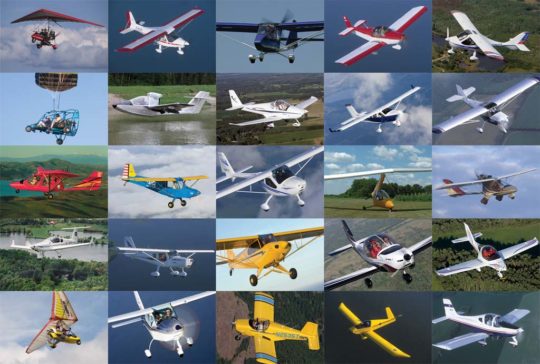 This report took a bit more time as the effort to begin counting Part 103 ultralights altered our view of the FAA aircraft registration data. Most of you may prefer this simpler report, but the data hounds among readers can drill all the way down to the last aircraft on Tableau Public.
This report took a bit more time as the effort to begin counting Part 103 ultralights altered our view of the FAA aircraft registration data. Most of you may prefer this simpler report, but the data hounds among readers can drill all the way down to the last aircraft on Tableau Public.
As always, my sincerest thanks goes to our premier datastician Steve Beste. His work is the primary resource for this report. While I deeply appreciated the work done for years by former data guy (and personal friend), Jan Fridrich, Steve’s career in databases gave him skills that few others possess. Since he’s also “one of us” — a trike owner and pilot — Steve understands what we hope to achieve better than data experts outside affordable aviation.
We believe the following information is the best and most reliable found anywhere in the world. However, any sharp readers who see errors or omissions are encouraged to speak up; we have often benefitted from reader input and welcome any chance to improve our reporting.
2020 and Covid
Surviving or Thriving?
Steve Best summarized, “Registrations grew by about 4% in 2020, down from 10% growth the year before.”
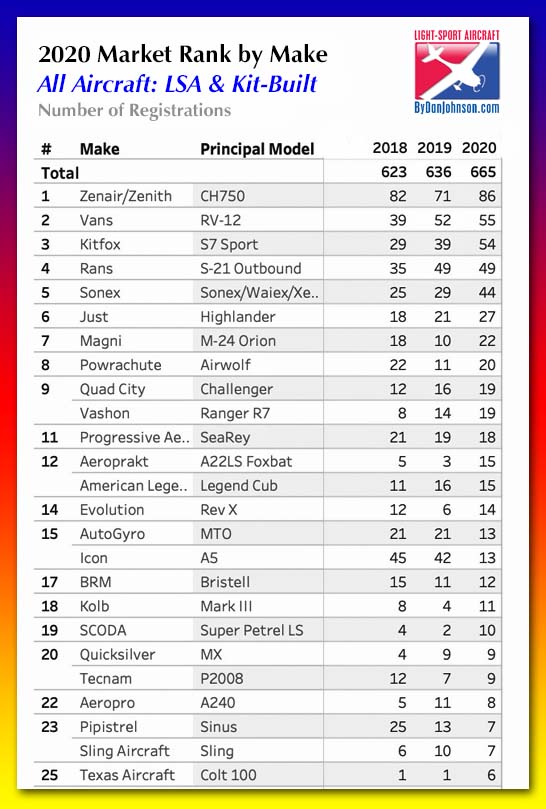
Other than Part 103 vehicles…
“The market splits into three distinct categories,” Steve began. He listed: “1️⃣ Zenair/Zenith, which registered* almost twice as many aircraft (86) as anyone else in 2020, followed by 2️⃣ the next four, each with over 40 registrations in 2020, and then 3️⃣ everyone else.” Trailing the longtime leader of this segment was Van’s and their RV-12 (we do not cover the other models Van’s sells), followed by Kitfox, Rans, Sonex, and Just.
“The leading registrations were almost all kit-built planes that can be flown by someone with a Sport Pilot certificate or using those privileges with a higher certificate — hence, “Sport Pilot kits.” Van’s Aircraft’s RV-12 can be bought factory-built as an SLSA, but of the 54 RV12s registered in 2020, only 11 were RTFs.”
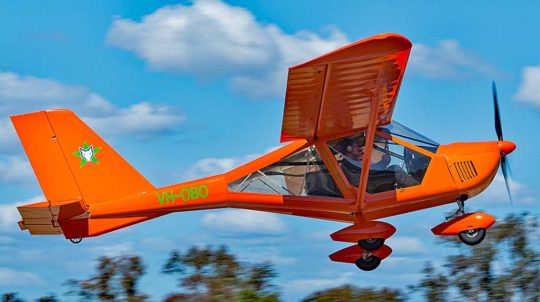
Aeroprakt A-22 SLSA — photo from JetPhotos.net, photographed by Dallas Presser ©.
Builders completed their kit-built planes at a good pace in 2020. In the chart below, the red line shows factory-built aircraft, SLSAs and ELSAs. The brown line shows kit-built aircraft.
Steve observed, “Historically, most of ‘my’ kind of aircraft have been factory-built but that’s no longer true. Now factory-built and kit-built are on par.” Indeed kits have been rising faster since about 2015 — where from 2005 (when the first SLSA were accepted by FAA) through 2014, ready-to-fly aircraft were pulling away.
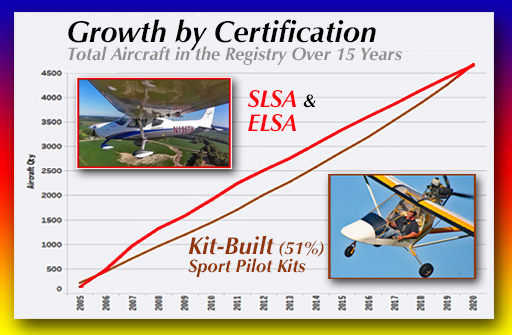
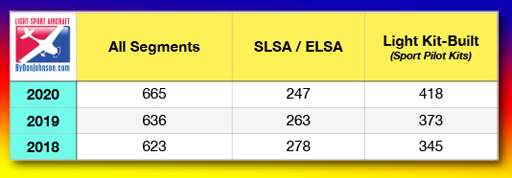
Special and Experimental
Light-Sport Aircraft
Aside from fixed-wing Sport Pilot Kits, Italian gyroplane maker Magni more than doubled its registrations.
Among ready-to-fly (RTF) models, Scoda’s Super Petrel amphibian had a breakout year.
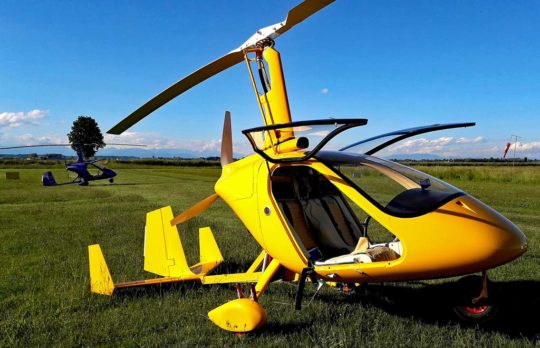
A Magni fully-enclosed M-22 Orion is decked out with Beringer “Shock Wheels.”
Yet all is not well. Icon sunk from 5th place to 15th, with just 13 registrations, down from 42 last year. AutoGyro’s numbers dropped 38%. “The largest gyroplane manufacturer in the world is reportedly undergoing a ‘corporate restructuring,’ Steve noted. We do not cover the Primary Aircraft category where some AutoGyro models may appear after they spent generously to achieve that certification with FAA. With the coming LSA regulation preparing (we believe) to allow SLSA gyroplanes, the advantage in having Primary Category approval is diminishing.
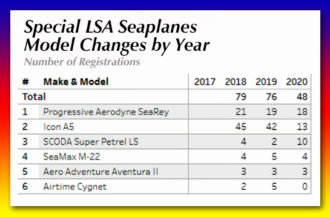
LSA Seaplanes — a category all its own. Two companies stand out from the rest in 2020.
Datastician Steve wrote, “Progressive Aerodyne‘s SeaRey is the leader among amphibians now that Icon has slipped.” This must be particularly delicious for those working at the Tavares, Florida airplane manufacturer. SeaRey existed long before Icon Aircraft. Once solely a kit builder, after adding SLSA models Progressive has steadily marched forward, even during ownership and management changes. Searey’s steady performance year in and year out wins the match against A5. These days, the two are priced dramatically differently and Searey remains a great value.
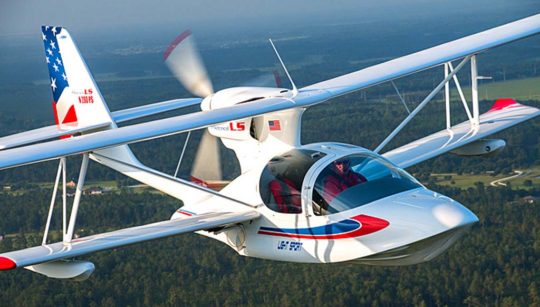
Brian Boucher flies the Scoda Super Petrel LS with gear retracted.
Coming in 2021, however, is New Zealand’s Vickers Wave that expect first flight this spring. Although presently a kit producer, Aero Adventure will being offering a fully-built model and its price point is sure to attract new buyers for this long-proven design.
One statement is true for LSA seaplanes and all other recreational segments: The ease of market entry compared to conventionally-certified “legacy” airplanes is sure to keep developers on their toes, demanding they continually make their aircraft more desirable.
Brazil’s Scoda Aeronautica‘s Super Petrel LS has joined the leaders with a breakout year in 2020. See video below.
Alternative Aircraft
Trikes/Gyroplanes/Powered Parachutes
Fixed wing, three axis aircraft have dominated Light-Sport Aircraft since the start. However, what I term “alternative aircraft” (anything not a fixed wing three axis model) have long made up about a quarter of the total and this remains true.
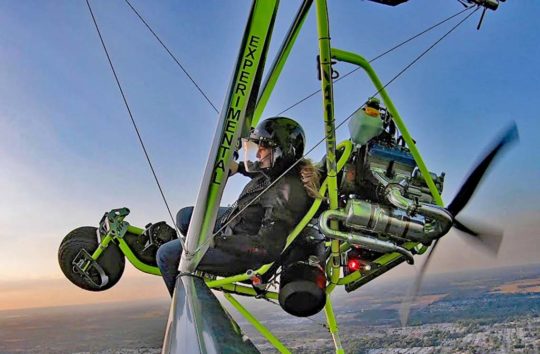
Photographed and flown by Amy Mednick of Evolution Trikes.
In this new year, I suspect we will find that Part 103 ultralights will factor in significantly. Among these lightest powered, wheeled aircraft, fixed wing, three axis will be the lion’s share but alternative aircraft represent a percentage you cannot ignore.
My expectation is that unit sales of Part 103 fixed wing and alternative models may exceed the total of SLSA/ELSA models sold. They are less costly by a wide margin — in some cases only one-tenth the cost of a deluxe Special LSA.
Reviewing the charts and tables accompanying this report, Steve noted, “Except for Magni, gyroplane registrations were down. This hot segment seems to have cooled a bit in 2020.” I would add that this could change a lot once the new regulation is announced and ready-to-fly gyroplanes can be sold by any company that earns FAA acceptance via ASTM industry consensus standards.
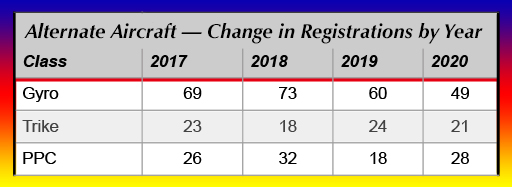

Some other PPC producers have models that show up nowhere. SkyRunner and it’s gnarly, large, and “twin-engined” combo powered parachute and ground vehicle made several sales to the U.S. government and military. These units require no FAA registration so do not appear in our tabulations. No other powered parachute make emerged into the statistics opening the door for new entrants.
• • • • • • •
That’s our look at affordable aircraft in 2020. Building a kit can be a largely solo activity and sport aircraft are flown solo most of the time. Therefore 2020 was not the horrid year it was for someone working in hospitality, restaurants, gyms, churches, or other “non-essential” activities.
If you’re one of many who kept flying in 2020, good for you! Enjoy your aerial freedom!
Scoda’s Super Petrel is one producer that had a stellar 2020. The following beautifully-done video offers a quick glance at production and shipment of this unusual bi-plane LSA seaplane.
* Registrations are not sales or deliveries. Kit-built aircraft are rarely registered in the same year they were delivered so kit registrations in 2020 may not reflect 2020 sales, which could have been lower or higher. Special and Experimental LSA of any kind are likely to be registered the same year they were manufactured. Over time, registrations and deliveries tend to align.


Does this mean the evtol market has no products for sale yet? Or will it be a separate listing at ByDanJohnson?
My interest is in the BlackFly evtol by Opener as previously mentioned. With Google co founder Larry Page owning Opener; no or almost no news comes out of Opener, lately. Have you received any info on the BlackFly from Opener that is not on their website? The Opener website info is now over a year old, Oshkosh 2019 appears to be the latest info; though some flying videos are newer. The unique BlackFly aircraft design allowing nearly vertical flight, a 3 foot run, with fixed wings and 4 propellers on each wing appears to not have an equal as a hybrid evtol vehicle; but I am looking for an equal. Only stability control appears as needed as on a modern controller. And the stability software appears to be no more sophisticated than any drone, just wonderful, and with triple redundancy. Opener says they have built 30 BlackFly evtols and have geared up to build more; but this info is over a year old. And Opener plans on flying BlackFlys to Oshkosh 2021 but I have not found an Opener Commitment that they are making this flight to Oshkosh. Except for the evtol technology of the BlackFly, I would be happy to look elsewhere for an equal to the Blackfly. I have searched the evtol data base for a BlackFly equivalent. I have not found an equivalent yet. Your help in finding a BlackFly equivalent is requested to email: tdwelander@gmail.com.
For the reasons you mention in your message and because I see zero evidence that even one of these multicopter designs has made it to the retail market, I will not be featuring them in any lists I create. I will continue writing about them because I find them interesting and because I believe they will arrive and could be popular. However, at least one of these companies has to get all the way to market before I will go further than writing articles of interest.
By the way, I pushed rather hard to fly Kitty Hawk Flyer but despite a good inside connection, I could not even get a reply from the company. Think of that what you will.
Dan: Nice work in pulling this data together. Quite insightful on the LSA market. One could say an acceptable year given Covid.
Unfortunately, it looks like some companies are leaving/left the US market: Evecktor; Flight Design (surprisingly); and of course Czech Aircraft-Sportcruiser in bankruptcy.
Do you have any thoughts/insight on the companies themselves in the USA LSA market?
Keeping our fingers crossed for a much better 2021!
Thank you for your kind words, however, you were not the only one to miss that companies not appearing in the top 25 had left the business. Those who want all the facts, including companies below rank number 25, should click the Tableau Public link and explore the facts… down to every single airplane counted.
Regarding the companies themselves, readers should recall that these are small companies and while that is a vulnerability at times, their small size allows them to be nimble enough to adjust to changing market conditions. Not all will do so perfectly, just like in every other industry, therefore some will fail. Most will not, thankfully.
Kudos to Steve for the analysis and standing up the tool!
Just to make it clear 🙂
Me, Jan Eggenfellner, have worked for 30 years to help with what we now see: People rejecting the steady increase in cost of participation in aviation, without the proof that they gain any value.
Viking sold more auto-conversion engines to registered Zenith aircraft for each of the 3 years listed.
So, the “traditional” way of fabricating expensive and low-volume engines, is dead and those that considered high-volume auto engines an “alternative” engine has now been proven wrong.
[Editor’s Note: While I prefer such exchanges do not happen here — social media may be the place for those exchanges — I already approved Jan Eggenfellner’s comment so I agreed in discussion with Jeff to allow this one as well. I prefer if this ends now. It is not my goal to disparage any business or customer especially when I lack full details of this disagreement.]
On the forums you don’t control, I am seeing many accusing you of fraud and many removing those engines from their aircraft due to reliability issues. One needs only to Google your name or Viking to determine your failed contribution to the space.
Aeroprakt had three new in stock from 2018-2019 registrations (demonstrators) and all those sold in 2020 so you can add three more to that total if you want. Not important though. I have 6 ordered and sold for the first half of 2021 so we’re off to a good start. Thank you both for all the work to get these reports published.
All aircraft with N-number registration are included in our numbers. Anyone can literally check every single aircraft counted, if desired. We don’t manually adjust data taken from FAA’s database. If an owner sends in registration forms late in the year, they may not appear until the next year. Certainly, in 2020, that outcome seems possible. We’ll get them all eventually.